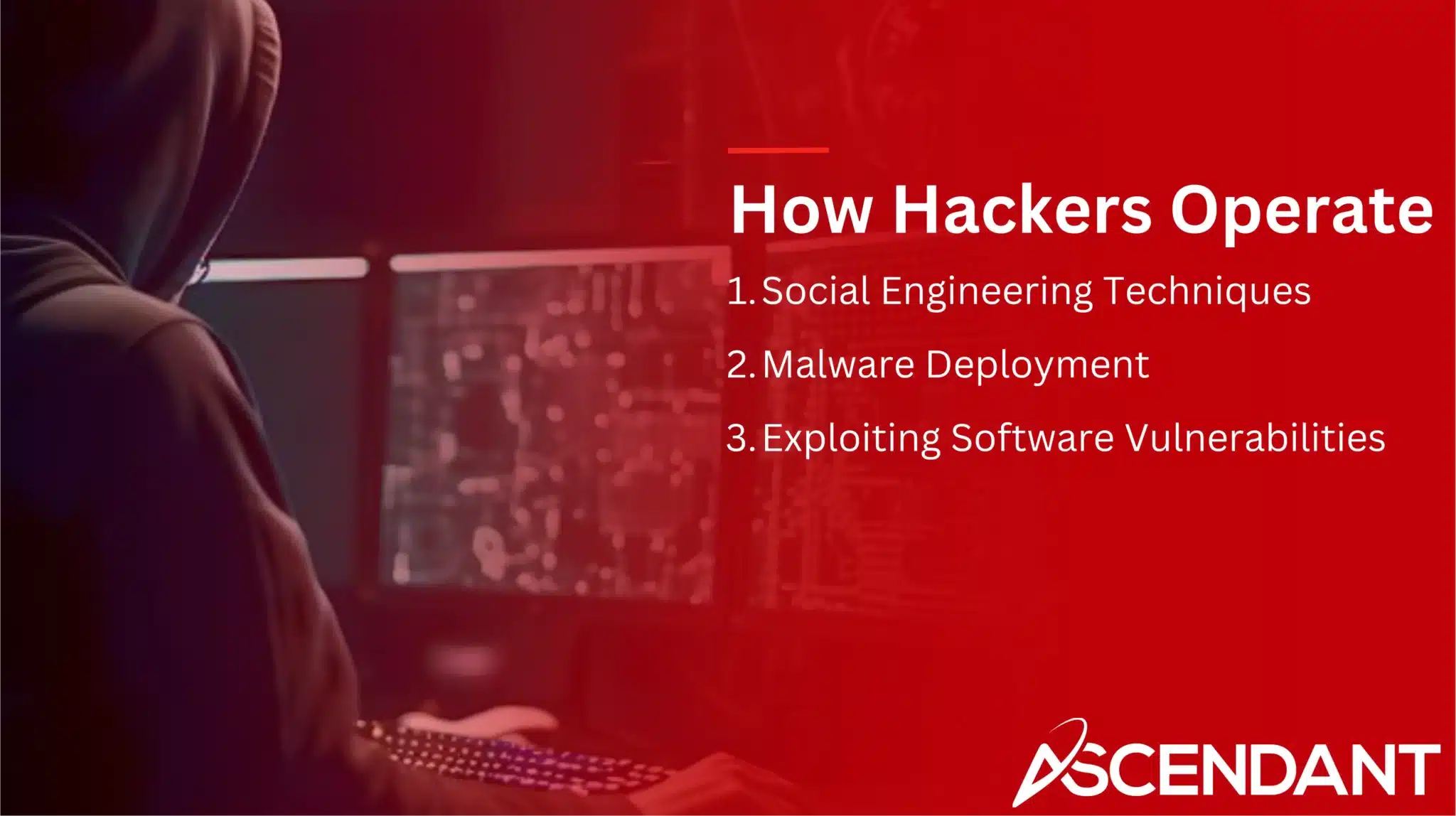Hackers are skilled individuals who can break into systems, whether to harm or help. This article unpacks what a hacker is, types of hackers, and their methods. Understanding hackers is vital for effective cybersecurity.
In This Article:
- What is a Hacker?
- How Hackers Operate
- Types of Hackers
- Common Hacking Techniques
- Motivations Behind Hacking
- The Evolution of Hacking
- Hacking Prevention Strategies
- Ethical Hacking and Its Importance
- The Future of Hacking
Key Takeaways
- Hackers are categorized into various types, including black hat, white hat, and gray hat, each with distinct motivations and methods affecting cybersecurity.
- Common hacking techniques such as social engineering, malware deployment, and exploiting software vulnerabilities pose significant threats to individuals and organizations.
- Preventive strategies for enhancing cybersecurity include using strong passwords, regular software updates, and vigilance against phishing to mitigate risks from hacking activities.
What is a Hacker?
An individual with exceptional technical capabilities who can tackle intricate problems is known as a hacker. This term covers a broad spectrum of people, ranging from highly skilled experts to those with less proficiency who engage in activities involving computer systems for diverse motives. The hacking phenomenon originated in the 1970s when tech aficionados began tinkering with technology. As time progressed, the image of hackers has evolved from rogue programmers or autodidactic prodigies to an understanding that acknowledges both benign and hostile endeavors.
Typically aiming to gain unauthorized entry into digital systems, application data, and confidential consumer details, hackers’ actions are often associated negatively. Not all hacking pursuits have detrimental intentions. For instance, ethical hacking employs similar techniques for identifying and rectifying security loopholes which ultimately bolsters cyber defenses.
In contrast though, some nefarious hackers might pilfer login information or commit identity theft while causing system disruptions or extorting companies through ransomware—activities that result in substantial financial burdens alongside reputational harm. Recognizing the various facets of hacker identities and their potential impacts lays foundational knowledge crucial for grasping cybersecurity’s expansive domain.
This base serves as a stepping stone towards delving deeper into how these individuals execute operations using distinct tactics tailored toward achieving their specific objectives, whether benevolent or malicious.
How Hackers Operate
To breach systems and obtain data without permission, hackers deploy numerous tactics that target technical flaws in software as well as the social vulnerabilities through deception. As these methods are varied and constantly advancing, it’s essential to grasp the key techniques utilized by hackers.
The primary strategies include exploiting software vulnerabilities, utilizing malware, and engaging in social engineering.
Social Engineering Techniques
Social engineering employs tactics of manipulation designed to exploit human mistakes in order to gain access to private information. Frequently used strategies involve trickery and assuming false identities, persuading people into divulging secret data. Phishing stands out as a widely practiced form of attack where perpetrators send counterfeit emails mirroring legitimate companies with the intent to pilfer sensitive details. As technological developments progress, it’s anticipated that social engineering assaults will grow more complex, utilizing artificial intelligence for crafting persuasive communications.
It is essential for both individuals and organizations to become educated on how to identify and combat these types of intrusions. By gaining an understanding of the techniques employed by social engineers, one can enhance their readiness and bolster security measures designed specifically against such deceptive approaches.
Malware Deployment
Hackers often employ the deployment of malware as a strategy to seize control over systems and pilfer data. This malware is commonly circulated through email attachments or links nestled within messages. Another widespread tactic is malvertising, which infects systems with malware via advertisements, bypassing the need for user engagement altogether. Trojan horses represent a category of this malicious software that hackers utilize to clandestinely access and expropriate sensitive information without detection by the target.
After successfully infiltrating a system, installed malware can disrupt operations and facilitate hacker dominance over affected devices. It’s crucial to acknowledge these tactics along with their associated risks in order to craft robust cybersecurity defenses that thwart such infections from occurring.
Exploiting Software Vulnerabilities
Utilizing a variety of tactics, hackers seek out software and system vulnerabilities to gain unauthorized entry. These nefarious individuals often probe for unguarded routes into systems or deploy Trojans that leverage security gaps. Software flaws like those seen in Meltdown and Spectre pose grave dangers, as they offer hackers substantial opportunities to penetrate defenses.
Phones that have been jailbroken are particularly susceptible, creating openings through which phone hackers can pilfer confidential information and propagate their malicious activities across other devices linked to the compromised phone. Awareness of these hacking strategies is essential for fortifying cybersecurity measures and safeguarding against looming threats.
Types of Hackers
There are several classifications for hackers, depending on their objectives and techniques. These groups comprise:
- Black hat
- White hat
- Gray hat
- Blue hat
- Red hat
- Green hat
- Cyber terrorists
- Hacktivists
- State-sponsored hackers
- S cript kiddies
- Malicious insiders
- E litehackers
Acknowledging the variety of hacker types aids in grasping the myriad drives and strategies they use.
In this part, we will explore the three main categories: blackhat, whitehat, and grayhathackers.
Black Hat Hackers
Cyber criminals known as black hat hackers leverage vulnerabilities in security for their own benefit and harmful intentions. Their motivations can range from simple theft to gaining notoriety, engaging in corporate espionage or conducting hacks on behalf of nation-states. These hackers frequently engage in the unauthorized access of sensitive data, compromise computer systems, and disrupt or dismantle websites. To penetrate networks, these criminal hackers might employ a variety of techniques including scripts.
The actions undertaken by black hat hackers can lead to serious ramifications such as monetary losses, damage to reputation, and potential legal problems for those impacted—both individuals and organizations alike. Understanding the tactics and driving forces behind these cybercriminals is essential when devising robust cybersecurity defenses aimed at thwarting their endeavors.
White Hat Hackers
Ethical hackers, who are often referred to as white hat hackers, utilize their expertise to enhance security measures by identifying and remedying system flaws with the consent of the proprietors. They perform penetration tests and assess vulnerabilities in order to detect possible susceptibilities as a would-be aggressor might.
By doing so, these professionals aid businesses in strengthening their protective barriers and fostering confidence among clients and stakeholders.
Gray Hat Hackers
Gray hat hackers occupy a space that falls between the intentions of black hat and white hat hackers. While they access systems without authorization, their goals are not malevolent or profit-driven. These individuals often act out of curiosity or to demonstrate the presence of security weaknesses, sometimes choosing to make these vulnerabilities known in order to promote awareness. Nevertheless, such revelations can inadvertently serve as beacons for malicious actors by revealing system flaws.
The conduct of gray hat hackers brings ethical dilemmas into focus, emphasizing the importance of finding equilibrium within cybersecurity practices—ones that foster appropriate vulnerability disclosure and subsequent corrective measures.
Common Hacking Techniques
To infiltrate systems and obtain data without permission, hackers utilize several prevalent hacking strategies. Techniques such as cracking passwords, executing distributed denial of service (DDoS) attacks, and implementing keylogging are among the methods used to gain unauthorized access. Identifying these tactics is critical for creating robust security protocols aimed at defending against cyber-attacks.
Password Cracking
Through a methodical process of trial and error, often deploying straightforward algorithms to create diverse combinations, password cracking is aimed at systematically deducing passwords. This technique is crucial for hackers in their efforts to gain unauthorized access to accounts, and its success can result in critical security compromises that impact individuals as well as organizations.
Implementing robust passwords along with multi-factor authentication can considerably diminish the likelihood of successful password cracking attempts.
Distributed Denial of Service (DDoS) Attacks
Servers can become inundated with bogus traffic due to DDoS attacks, leading to genuine requests being neglected and server resources becoming excessively burdened. Hackers may instigate these assaults by compromising routers and commandeering zombie computers, which they then use for spam distribution or the execution of DDoS attacks.
DDoS attacks have far-reaching consequences such as substantial interruptions in service provision and could lead to monetary damages for companies. Fortifying security defenses is a crucial measure that organizations can take to lessen the detrimental effects of DDoS assaults.
Keylogging
Keyloggers are nefarious instruments programmed to observe and log every keystroke entered on a computer or device, thereby seizing sensitive data including personal details and login credentials. This technology can severely compromise the safety and confidentiality of users, elevating the risk of identity theft as well as illicit entry into private information.
To guard against keylogging attacks, it is advisable to utilize anti-malware applications alongside maintaining robust cybersecurity practices.
Motivations Behind Hacking
Understanding the various motivations that propel hackers is vital in crafting effective countermeasures against their activities. These individuals are often motivated by desires for financial rewards, involvement in political and corporate espionage, or simply the pursuit of recognition and the thrill of overcoming challenges.
In this section, we explore the key drivers behind hacking behaviors.
Financial Gain
The primary incentive for hackers is the potential for financial gain, with many participating in ransomware attacks to demand payment. Cybercriminals may profit by trading stolen financial information on the dark web.
Understanding that the pursuit of money drives hacking can assist in creating focused defensive strategies to counter these types of security risks.
Political and Corporate Espionage
Hackers are employed by nation states for political aims, including the theft of confidential information and election tampering. Corporate espionage is another avenue where hackers pilfer trade secrets to gain a market edge. Hacking might be deployed in support of particular political ideologies or social campaigns.
Understanding the motivations behind such espionage—whether it’s political or corporate—is critical as it can have far-reaching consequences on both national security and business integrity, often resulting in considerable economic loss and damage to reputation. This knowledge is essential when formulating defense tactics to secure sensitive data against unauthorized access and espionage activities.
Notoriety and Challenge
Numerous hackers are driven by the quest for fame and the thrill of breaching sophisticated security systems. Among their peers, achieving notoriety serves as a badge of honor and establishes one’s standing, particularly when hackers endeavor to display their technical prowess.
Nevertheless, this ambition for recognition brings into question the morality of hacking practices considering the potential adverse effects they may have on both people and societal structures.
The Evolution of Hacking
The concept of ‘hacking’ emerged in the 1970s and has since experienced a notable evolution. Originally, teenage individuals were often responsible for breaching major computer systems, resulting in an adverse public image of hackers. Over time, hacking techniques have advanced and diversified, reflecting a broader spectrum of strategies used by hackers.
Today’s hacking has transformed into an industry worth billions of dollars, underlining its profound influence on cybersecurity as well as societal implications. The infamous Yahoo! Data breach that occurred in 2013 stands out among history’s most significant hacks and demonstrates the critical necessity for strong cybersecurity defenses.
Acknowledging how hacking has progressed over time is crucial to fully understand the current security environment and to gear up for prospective future challenges within this field.
Hacking Prevention Strategies
To bolster cybersecurity and thwart hacking efforts, a comprehensive strategy is necessary. This involves employing robust passwords and multi-factor authentication, staying on top of software updates, and remaining alert to phishing attempts. Such measures target the diverse techniques hackers employ in their attempts to breach systems and acquire data without permission, ultimately reinforcing security defenses against unauthorized access.
Strong Passwords and MFA
Data breaches and cyber-attacks often occur due to the use of weak passwords or vulnerable account credentials. To establish robust protection, it is advisable that a password incorporates not only upper and lower-case letters, but also digits and special symbols, extending to a minimum length of 12 characters. It’s critical for enhanced security that these intricate passwords exceed 10 characters in length and are unique for each separate account.
Adding multi-factor authentication introduces an additional safeguarding measure, significantly complicating efforts by hackers to gain unauthorized access.
Regular Software Updates
It is vital to consistently update your software and operating system in order to thwart hackers who might take advantage of vulnerabilities that have not been corrected in your computer system. By applying security patches, you can address known weak spots and boost the security of your system as a whole. It’s important to download software exclusively from reputable sources to avoid malware intrusions.
Adhering to these measures plays an essential role in safeguarding the security and integrity of digital devices.
Vigilance Against Phishing
Be cautious of phishing emails or messages, as these are frequently used by hackers to initiate successful attacks. Legitimate institutions and banks will never solicit sensitive information such as login credentials, social security numbers, or credit card details through email communications.
It’s crucial to be aware of the strategies employed by hackers in order to effectively guard against phishing attempts. Essential measures include steering clear of insecure websites, refraining from downloading attachments that have not been verified, and resisting the urge to click on links contained within emails from unknown sources.
Ethical Hacking and Its Importance
Ethical hacking employs legally sanctioned hacking methods with the goal of improving security measures for beneficial results. Through penetration testing, ethical hackers seek out system weaknesses before black hat hackers have a chance to take advantage of them, subsequently informing organizations and their vendors about these vulnerabilities. They conduct evaluations from the viewpoint of a possible attacker to help companies reinforce their protection mechanisms.
By working with ethical hackers, businesses foster confidence among clients and stakeholders by showing dedication to cybersecurity practices. Playing an integral part in forestalling cyber-attacks, ethical hackers are key to elevating security standards through the detection and resolution of system vulnerabilities.
Impact of Hacking on Businesses
In 2024, the cost incurred from data breaches averaged at $4.88 million, marking a noticeable uptick compared to earlier years. Following the public announcement of a breach, companies typically witness an immediate decline in their stock value by approximately 3.5%. It is estimated that cybercrime will inflict a staggering financial toll on businesses worldwide amounting to $10.5 trillion by 2025, thereby establishing itself as a formidable threat across various industries.
The healthcare sector often faces severe reputation damage following breaches and tends to underperform with the Nasdaq index — falling behind by about 10.6% after such incidents occur. Hackers frequently infiltrate rival firms aiming to purloin confidential information that could potentially offer competitive edge.
Consequences for security violations can extend into legal realms with fines being imposed due to non-compliance issues, personal liabilities placed upon security officers, and collective lawsuits brought forth by individuals who have been impacted negatively by these breaches. Acknowledging how profoundly hacking affects enterprises highlights why it’s critical for them to allocate resources towards developing strong cybersecurity defenses.
The Future of Hacking
The evolution of hacking has seen it transform from basic tinkering to an intricate international industry of cybercrime. There is a surge in the allocation of resources toward cybersecurity, with projections suggesting that global expenditures will surpass $1.75 trillion over the four-year period from 2021 to 2025. As we face a changing array of cyber threats, there’s also a noticeable advancement in malware sophistication. Its modular construction enables perpetrators to modify their strategies swiftly.
It is anticipated that cyber insurance will catalyze the need for thorough cybersecurity evaluations as insurers incorporate these assessments into their risk appraisal process during underwriting. Acknowledging and understanding these forthcoming developments are crucial steps in equipping oneself and adjusting appropriately within this dynamic field of cybersecurity.
Summary
We have delved into the complex realm of hackers, examining their beginnings, incentives, strategies they utilize, and the consequences for companies. Recognizing various hacker profiles and their approaches is key to crafting robust cybersecurity defenses. Ethical hacking is essential in spotting weaknesses and enhancing security.
Looking ahead, it’s imperative to emphasize strong cybersecurity investments. Maintaining awareness and alertness allows us to fortify our defense against constantly advancing hacker threats. Adopting ethical hacking alongside preventive measures can contribute to a safer digital environment.
 Frequently Asked Questions
Frequently Asked Questions
What is the full meaning of hacker?
A hacker is an individual skilled in information technology who illegally gains access to computer systems to manipulate or steal data. Their actions often involve exploiting vulnerabilities for various malicious purposes.
What is a fancy word for hacker?
A sophisticated term for “hacker” could be “cyber-terrorist” or “cyberpunk.” Alternatively, “programmer” or “coder” may also serve as refined synonyms, depending on context.
What does a hacker do?
A hacker manipulates digital devices to gain unauthorized access, often for malicious purposes such as stealing or destroying data. While some hackers aim to exploit systems for personal gain, others may operate ethically to improve security.
What is the primary motivation behind hacking?
The primary motivation behind hacking is financial gain, as many hackers exploit security vulnerabilities for personal profit. This focus on monetary reward drives much of their illicit activity.
How do hackers use social engineering to gain access to systems?
Hackers exploit social engineering by utilizing manipulation techniques such as impersonation and phishing to deceive individuals into disclosing sensitive information, ultimately gaining unauthorized access to systems.


